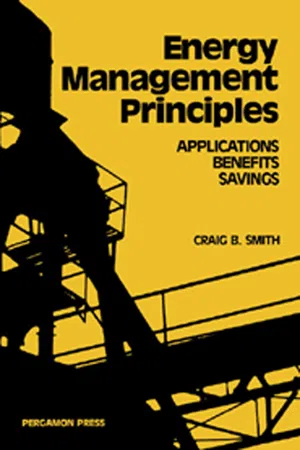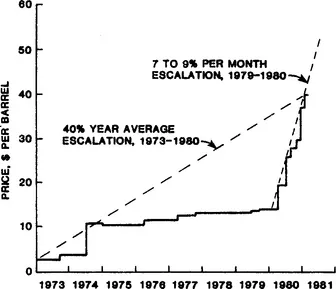![]()
1
Introduction
Publisher Summary
This chapter provides an overview of the rapidly changing world energy situation and outlines the role of energy management. The society is at the beginning of a new era of change, an era of possibly greater fundamental significance than the industrial revolution. Around the world, in industrial and nonindustrial nations alike, there is a growing awareness of the central role played by energy in the economy, food supply, and national productivity. The energy management concepts promise to be of increasing importance in enabling mankind to meet the challenges of the future: providing employment, food, and security for future generations. The finiteness of energy resources is also moving the world closer to war. The resources of all types are essential to war and in themselves can be causes for war and for the rise and fall of nations. Therefore, the efficient energy use not only increases one’s independence of external energy supplies but also helps defuse a potential unstable international situation.
What if wealth and power, war and conquest, were only surface illusions, unworthy of a mature mind? What if this science of hypothetical atoms and genes, of whimsical protons and cells, of gases generating Shakespeares and chemicals fusing into Christ were only one more faith… .?
W. Durant, 1954
The Story of Civilization
INTRODUCTION
Energy is essential to life and survival. Reduced to bare essentials, stripped of thermodynamics, economics, and politics, this is how we must view it.
Energy may well be the item for which historians remember the last half of the twentieth century. We are at the beginning of a new era of change, an era of possibly greater fundamental significance than the industrial revolution. For several centuries mankind has grown lazy, lulled into complacency by the ease with which multitudes could be fed, housed, and transported using the abundant supplies of low-cost energy which were readily available.
Then, in less than a decade (1973–1981) the bubble which had taken 114 years to swell (since Drake’s first well in 1859) finally burst. Long unheeded warnings took on a prophetic aspect as fuel shortages and rising costs nearly paralyzed the industrial economies and literally shocked the world into an inflationary period which is not yet ended.
It is remarkable that our lives could be so affected by one perturbation to the world economy. Figure 1.1 shows what this perturbation was — a tenfold increase in crude oil prices in less than a decade.
Fig. 1.1 Crude oil price increases. Source: Compiled by the author.
Of course, in reality the problem is much more complex, involving not only oil prices but also the uneven geographical distribution of energy resources, the exponential growth of populations and fuel consumption, the desires of poorer nations throughout the world, political and national security considerations, and long-term environmental effects.
Tragically, the finiteness of energy resources may also be moving the world closer to war. Resources of all types are essential to war, and in themselves can be causes for war and for the rise and fall of nations. Twenty-four centuries ago, Greece denuded its forests building ships to continue the Peloponesian Wars; in 1940, Germany seized the Rumanian oil fields at Ploesti when it could no longer import petroleum due to the British blockade; the Israelis captured the Egyptian fields in Sinai. In its September, 1980 attack on Iran, Iraq went after the huge Abadan refinery complex and other strategic points in Iran’s oil-producing western province of Khuzistan.
Efficient energy use therefore not only increases one’s independence of external energy supplies, but also helps defuse a potential unstable international situation.
This chapter provides an overview of the rapidly changing world energy situation, and outlines the role of energy management.
RESPONDING TO A CRISIS
In 1973, the Community Concourse (six city-owned buildings in San Diego, California) used 21 million kWh of electricity per year at a cost of $270,000. By the end of 1974, the costs were $230,000 annually, even though stringent economy measures had been instituted immediately following the oil embargo in October, 1973. These measures, which included an employee awareness campaign, adjustment of lighting levels by delamping, thermostat setback, and revised operating procedures on the building HVAC systems, resulted in a savings of 7 million kilowatt hours per year, or roughly 33 percent. In spite of these savings, the costs had quickly increased back to nearly the original level. Further studies were undertaken to achieve additional savings in energy. By the end of 1975, an overall reduction of 37 percent from the 1973 levels had occurred. Meanwhile, costs were now $330,000 per year (see fig. 1.2). The significant point is, however, that without the energy management activities which had been undertaken, the costs of operating this facility in 1976 would have doubled to approximately $520,000 per year, and the taxpayers would have had to support this increase. This case history describes what happened in six large municipal buildings. There are thousands of buildings throughout the United States for which similar stories may be told.
Fig. 1.2 Historical electricity use — Community Concourse (San Diego, California).
Meanwhile, farther to the north, citizens in Seattle were asked to approve participation in a nuclear power plant project. The project was under consideration because additional low-cost hydroelectricity capacity was no longer available.
After an extensive investigation in 1976, Seattle decided not to participate in the new power project. Instead, energy management efforts were to be undertaken, with savings gained by more efficient energy use being used to meet future growth needs. This bold proposal — not without the possibility of some severe economic penalties if Seattle’s optimism is overstated — hypothesizes that nearly half (230 MW) of predicted future growth needs by 1990 can be met by an energy management program. The program includes formation of a city office of conservation, residential insulation retrofit, new construction standards, appliance standards, energy use disclosure reports, heat pump projects, and energy management research and development.
Two years after the embargo, Arizona moved to ban all new hook-ups of natural gas. Other states began reviewing energy supplies and uses. New Mexico proposed a tax on energy exported out of the state. Three years later, the California Public Utility Commission established priorities for natural gas use; it was prohibited as a fuel in generating plants. Over the next several years natural gas was to be phased out in industry; first as a boiler fuel, then for all process heat applications for which a substitute fuel — usually oil — could be found.
The impact varied from firm to firm. In a large manufacturing plant, the potential loss of gas-fired boiler capacity led to an investigation of heat recovery possibilities. It appeared possible to reclaim heat dissipated by 5,000 hp air compressors; before, the heat was extracted by interstage coolers and discharged to the atmosphere in a cooling tower.
In a smaller plant which manufactured agricultural antibiotics, the crisis meant that no natural gas was available to fuel a drying oven needed to expand the plant’s capacity. Looming in the future was the possibility of fuel curtailment, resulting in a shutdown of the plant’s boiler and existing drying ovens.
Rising energy prices have hit hard at agriculture by increasing the cost of fuels, irrigation, fertilizer, pesticides, transportation, and food processing. Feed lot operations are particularly energy intensive. Energy audits indicate that feed lot beef requires an input of 20 to 30 energy units for each energy unit of edible meat produced. Much of today’s high yield agriculture is energy intensive; as fuel prices increase, so do food costs.
In Los Angeles, an emergency ordinance was passed following the oil embargo when it became apparent the city did not have sufficient fuel to meet all needs. Commercial users were asked to reduce electricity use by 20 percent; industry by 10 percent; and residential consumers by 10 percent.
One Southern California family installed fluorescent lighting, better insulation, additional switches, changed thermostat settings, and operated appliances more efficiently. As a result, annual energy use for a family of four went from 6,859 kWh per year ($ 156 per year) in 1972 to 3,868 kWh per year in 1974. By then, rising prices had brought the cost back up to $141 per year; in 1975 the cost was the same as 1972, even though the usage had dropped to about 56 percent of the pre-embargo level. Yet, without the energy management efforts extended by this family, they would have experienced a sharp increase — perhaps a doubling — of utility costs.
Each of the examples discussed above has been drawn from the author’s experience. They have one thing in common: they illustrate the response being taken all over the world by people who are now encountering rapidly escalating energy prices. These activities illustrate the practice of energy management.
PURPOSE OF THIS BOOK
When energy problems caused by rapidly increasing demand in the face of dwindling fuel supply first became apparent in the early 1960s, the immediate response was to seek new supplies and alternative fuels. Later, consideration was given to the user as a means of conserving fuels and capital: by improving end-use efficiency, supply problems were automatically eased. The oil embargo of 1973 gave an additional stimulus to users — in both the industrialized nations and in the third world — to make the most effective use of fuels and energy.
Approaching energy problems from the user’s end, rather than the supply end, introduces new challenges. First, the number of users is much greater than the number of suppliers, thus complicating the problem. Second, communication with users is difficult due to their number and diversity. Third, due to its diversity, end-use is not readily approached by legislative or regulatory controls. Fourth, the technological sophistication of end-users varies widely, as do their capital resources, limiting the technical improvements which are feasible. Finally, the nearly infinite variety of uses invokes a need for a great many different technologies, materials, and equipment.
On the positive side, changes made by end-users can have an immediate (days) or short-term (months) impact on energy use, compared to five to ten years needed to add energy supply capacity. The previous availability of energy, coupled with its low cost, resulted in situations in which there was little incentive for more efficient energy use. Both of these conditions are changing, so users now perceive economic signals (rising prices) which provide positive encouragement to reduce or eliminate all unnecessary uses of energy. Finally, even though the diversity of end-use technology is considerable, it appears that there are certain basic approaches or “general principles” which apply in a wide variety of applications.
The purpose of this book is to set forth some of these basic principles, provide examples, and supply a general methodology and the tools t...


